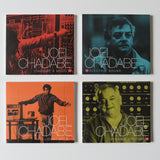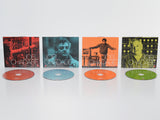Joel Chadabe: collection (4x CD releases)
EU/UK customers: this item is also available from our European shipping location in Poland for cheaper shipping / no duty fees.
Please visit http://suction-eu.shop.
ABOUT THIS RELEASE:
A collection of the first four CD releases by Joel Chadabe at a special combo-deal price. CDs are brand new / sealed.
Joel Chadabe (born 1938) is a composer, author, NYU professor, and internationally recognized pioneer in the development of interactive music systems. Chadabe: “For me, creating music with electronics has meant exploration, discovery, creativity, research, performance, and sharing knowledge and ideas with others in a new world of sound. My goal is to share those attitudes and activities with students and colleagues into the future.”
On Chadabe & Moog (2017 - EMF CD 084) - music recorded between 1966-1972: “In 1966, I began to experiment with a Moog synthesizer at the State University of New York at Albany. In recalling those early days, I created automatic synthesized processes. For the fixed media compositions, I developed an unusual approach. I asked Bob Moog to build a four-track mixer with piano keys that functioned more like gates than mixer potentiometers, so I could pass recorded sounds through the tracks by pressing the keys and mix those recorded sounds in with synthesized sounds. It was a semi-random approach, often producing surprising and excellent results. After working with the relatively small synthesizer for a year or two, I got an idea for an analog-programmable system based on sequencers. I drew pictures of different types of sequencers, showed them to Bob, got a grant to commission Bob to build a synthesizer with those sequencers, and he then built a wonderful system that was, of course, far better than what I had drawn on paper. We called it the CEMS (Coordinated Electronic Music Studio) System. For me, it was an incredible musical opportunity. By the end of 1969, I was discovering new ways of programming sounds…. It was also a period of technical difficulty in that some of the equipment was sensitive to heat and humidity. At the same time, technology was developing and everyone seemed to be exploring new technologies for music.”
On Electric Sound (2017 - EMF CD 085) - music recorded between 1972-1987: “In the 1970’s, technology was developing and everyone seemed to be exploring new technologies for music. Roger Meyers, my programming partner, and I began to use PDP-11 minicomputers with Bob Moog’s analog equipment….In 1977, I received a grant and bought the first Synclavier, a digital synthesizer/computer system built by Sydney Alonso and Cameron Jones at New England Digital Corporation. Roger and I began to program it, and I composed Solo, pointing me towards a new way of thinking about composing music. From that time to the present, when people ask me what I do as a composer, I explain that I do not compose pieces, I compose activities. A ‘piece’, whatever its content, is a construction with a beginning and end that exists independent of its listeners and within its own boundaries of time. An ‘activity’ unfolds because of the way people perform; and consequently, an activity happens in the time of living; and art comes closer to life.”
On Intelligent Arts (2020 - EMF CD 088) - music recorded between 1973-1981: “By the middle of the 1970s, various digital devices were used for the first times in music, and I became interested in digital synthesizers. I was able to order a Synclavier, to my knowledge the first digital synthesizer. It had been built with my specifications, among them an analog/digital converter, programmable clock, and an ability to write software programs. And to complete the system, I asked Bob Moog to build two antennae, as modified theremins, which allowed me to control the system by waving my arms in the air…. In the early 1980s, MIDI emerged as a global standard for equipment and software. I used a Macintosh computer running M, an interactive composing and performing program developed at Intelligent Music by David Zicarelli and others in the company. In 1981, I coined the term ‘interactive composing.’ The ultimate significance of interactive composing is that it represents a new way for composers and performers to participate in a musical activity. I offer my nontechnical perception that good things often happen — in work, in romance, and in other aspects of life — as the result of a successful interaction during opportunities presented as if by chance. To that thought, I would add only that it seems to me reasonable that such a perception should also find expression in music.”
On Dynamic Systems (2020 - EMF CD 089) - music recorded between 1997-2009: “One basic characteristic of music today is the use of electronics, not only in new sounds but also in new structures which operate as ongoing dynamic processes. As against a traditional musical structure, which has a beginning and an end defined by chords, a dynamic process has no specifically defined boundary in time. It functions as a unique ongoing process. It may start or stop. But it has no structural beginning and no structural ending. The music on this CD exemplifies various dynamic processes as approaches to performance.”







